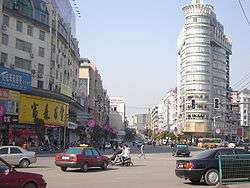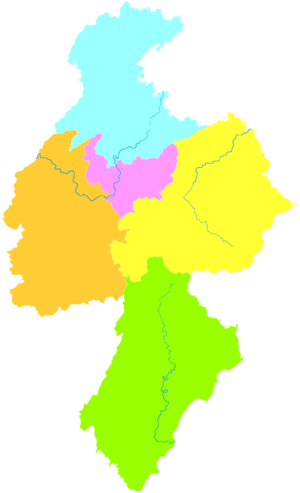Pingxiang
Pingxiang (simplified Chinese: 萍乡; traditional Chinese: 萍鄉; pinyin: Píngxiāng; Wade–Giles: P'ing-hsiang) is a medium-sized prefecture-level city located in western Jiangxi province, People's Republic of China.
Pingxiang 萍乡市 Pingsiang | |
|---|---|
 Downtown Pingxiang | |
.png) Location of Pingxiang City jurisdiction in Jiangxi | |
| Coordinates (Pingxiang government): 27°39′32″N 113°53′13″E | |
| Country | People's Republic of China |
| Province | Jiangxi |
| Municipal seat | Anyuan District |
| Government | |
| • Mayor | Li Xiaobao |
| Area | |
| • Prefecture-level city | 3,824 km2 (1,476 sq mi) |
| • Land | 3,824 km2 (1,476 sq mi) |
| • Urban | 1,073 km2 (414 sq mi) |
| • Metro | 1,073 km2 (414 sq mi) |
| Population (2010) | |
| • Prefecture-level city | 1,854,510 |
| • Density | 480/km2 (1,300/sq mi) |
| • Urban | 893,550 |
| • Metro | 893,550 |
| Time zone | UTC+8 (China Standard) |
| Area code(s) | 0799 |
| ISO 3166 code | CN-JX-03 |
| Website | www |
Geography and climate
Pingxiang is a limitrophe city between Jiangxi and Hunan provinces. Approximately 110 kilometers from Changsha, Hunan, about 260 kilometers from Nanchang. Most of the area around the city is hilly and mountainous, although the city itself is relatively flat. As a sub-tropical climatic city, Pingxiang has mild winters, long and hot summers, with plenty of rainfall. The annual average temperature is 18 °C.
| Climate data for Pingxiang (1981–2010 normals) | |||||||||||||
|---|---|---|---|---|---|---|---|---|---|---|---|---|---|
| Month | Jan | Feb | Mar | Apr | May | Jun | Jul | Aug | Sep | Oct | Nov | Dec | Year |
| Record high °C (°F) | 25.8 (78.4) |
30.5 (86.9) |
35.0 (95.0) |
35.7 (96.3) |
37.3 (99.1) |
37.6 (99.7) |
40.1 (104.2) |
41.0 (105.8) |
39.2 (102.6) |
35.9 (96.6) |
31.8 (89.2) |
25.5 (77.9) |
41.0 (105.8) |
| Average high °C (°F) | 9.3 (48.7) |
11.6 (52.9) |
15.7 (60.3) |
22.5 (72.5) |
27.6 (81.7) |
30.5 (86.9) |
34.2 (93.6) |
33.4 (92.1) |
29.4 (84.9) |
24.3 (75.7) |
18.5 (65.3) |
12.6 (54.7) |
22.5 (72.4) |
| Daily mean °C (°F) | 5.5 (41.9) |
7.7 (45.9) |
11.4 (52.5) |
17.6 (63.7) |
22.5 (72.5) |
25.8 (78.4) |
29.0 (84.2) |
28.0 (82.4) |
24.3 (75.7) |
19.0 (66.2) |
13.2 (55.8) |
7.6 (45.7) |
17.6 (63.7) |
| Average low °C (°F) | 2.9 (37.2) |
5.0 (41.0) |
8.4 (47.1) |
14.1 (57.4) |
18.7 (65.7) |
22.3 (72.1) |
24.8 (76.6) |
24.3 (75.7) |
20.7 (69.3) |
15.3 (59.5) |
9.5 (49.1) |
4.2 (39.6) |
14.2 (57.5) |
| Record low °C (°F) | −3.9 (25.0) |
−3.9 (25.0) |
−1.7 (28.9) |
1.5 (34.7) |
9.0 (48.2) |
13.4 (56.1) |
17.4 (63.3) |
18.1 (64.6) |
12.6 (54.7) |
2.7 (36.9) |
−1.1 (30.0) |
−9.3 (15.3) |
−9.3 (15.3) |
| Average precipitation mm (inches) | 83.5 (3.29) |
108.3 (4.26) |
178.5 (7.03) |
204.0 (8.03) |
221.1 (8.70) |
238.2 (9.38) |
150.1 (5.91) |
132.9 (5.23) |
85.1 (3.35) |
81.2 (3.20) |
83.7 (3.30) |
58.2 (2.29) |
1,624.8 (63.97) |
| Average relative humidity (%) | 84 | 84 | 84 | 83 | 82 | 83 | 77 | 80 | 80 | 79 | 79 | 80 | 81 |
| Source: China Meteorological Data Service Center | |||||||||||||
History
Archaeological evidence suggests that Pingxiang was first settled during the Stone Age. During the Han dynasty, it was part of Yichun. In 267, during the time of the Three Kingdoms, it became Pingxiang County, which made it a higher level of administration than what it is today. During the Tang Dynasty (618-907), it was part of the Jiangnanxi Circuit, and was called Yuanzhou. Its name and area of administration were changed many times until 1970, when it assumed its present form.
Administration
Pingxiang has direct jurisdiction over two urban districts, one economic development area, three counties, 28 towns, 18 townships, and 7 sub-districts.
Urban districts:
- Anyuan District (安源区)
- Xiangdong District (湘东区)
- Anyuan Economic Development Zone (安源经济开发区)
Counties:
- Shangli County (上栗县)
- Luxi County (芦溪县)
- Lianhua County (莲花县)
| Map | |||||
|---|---|---|---|---|---|
Demographics
The population of the total administrative area of Pingxiang was estimated to be 1,874,000 at the 2012 census.
Economy
In 2013, the GDP was 79.2 billion RMB, an 8.2% growth over the previous year. Rural income was 11,100 RMB, a 10.5% growth over 2012 and urban income was 23,489 RMB, an 11% growth over 2012 (without regard to inflation).
Resources
Pingxiang has abundant water and mineral resources. Five rivers flow across the land which delivers approximately 2.626 billion cubic meters per year. Coal, iron ore, limestone, kaolin and granite are the most abundant minerals of the city. Even today, the Pingxiangren or local people proudly refer to their city as the "coal center of southern China."
Transportation
Pingxiang is a regional hub for transportation. It is about 1.5 hrs drive to the CSX from downtown of Pingxiang. A couple of highways and the main rail line between Changsha and Nanchang run through the city. The city has had a high-speed railway since September 2014.
Tourism
Wugong (also known as WooKong) mountain is a national well known place for tourism. It lies in the east of Pingxiang, 45 minutes from downtown. The highest altitude is 1,918 meters while the average altitude is about 1,500 meters. Most of the landscape remains virginal in despite of some necessary infrastructures that benefit tourists.
Yangqi mountain is famous for the religion of Buddhism, lies in north of Pingxiang, one hour's drive from downtown.
Nielongdong (also known as Sinful Dragon Cave) has a tale which refers to Chinese traditional religion and zodiac. This beautiful area is only twenty minutes north.
The historical buildings of the Anyuan Miners' and Railroad Workers' Club as well as the Anyuan Miners' Strike Memorial Hall preserve the memory on the influenc of the miners and railroad workers on the commonunist movement and are open for public visits.[1]
References
- "Anyuan Bowuguan". Retrieved 2020-05-18.
External links
| Wikimedia Commons has media related to Pingxiang, Jiangxi. |
